Hood in the chicken house: the best ways to equip the ventilation system in the house
Breeding chickens is a troublesome thing, so you need to try to get the most out of it. Good performance of poultry, along with other activities, provides an extract in the chicken coop. Without clean air, the health of chickens is at risk, therefore, egg production is reduced.
We suggest that you familiarize yourself with the methods and options for ventilation in the house. We give regulatory requirements for the construction of indoor pavilions for domestic birds. Based on our recommendations, you can provide the hens with a regular supply of fresh air.
We supplemented the detailed description of ventilation organization technologies with intuitive diagrams, photo selections, a video presentation of a proven system and a video guide.
The content of the article:
The role of ventilation in creating a house microclimate
In the chicken coop, as in any house, there are ammonia vapors dispersed throughout the room. If fresh air does not enter from the outside and harmful fumes reach a high concentration, its inhabitants begin to get sick, and in some cases this becomes the cause of death.
Feathered birds and heat are poorly tolerated, so a system that allows air to circulate is simply vital for them.
Without ventilation, air humidity is also difficult to control. Birds are equally bad in both an excessively wet and a dry room.
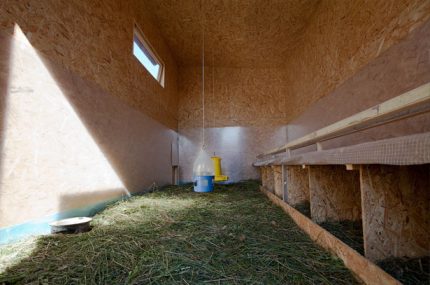
This problem becomes especially relevant in the winter, when the entire population is constantly in a confined space. Carbon dioxide, water vapor, plus toxic ammonia from the litter build up in the air. Rotting litter and food scattered on it are a good basis for the propagation of harmful microorganisms.
Just opening the door is not an option.This way of providing fresh air can create another problem - frostbite ridges. Dangerous for layers and sudden changes in temperature, drafts. Therefore, the presence of a competent scheme of general ventilation in the chicken coop in winter is a matter of extreme necessity.
Existing ventilation methods
There are 3 ways to ventilate a room where poultry is kept:
- natural;
- mechanical;
- combined.
The first is the most low-cost and is used in the presence of a small number of chickens. It is a simple airing, but it must also be arranged according to certain rules. Before deciding to make such ventilation in the chicken coop with your own hands, you need to take into account all the points during the design of the bird house.
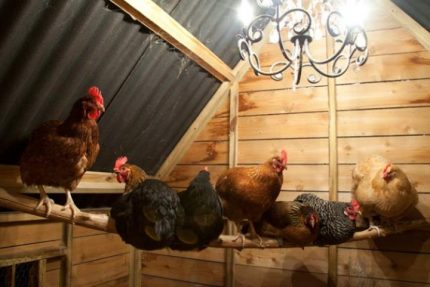
The second method of ventilation is more effective, but simple in implementation. If the farm has more than 20 birds, you should stop at this option.
Mechanical ventilation can be forced, exhaust or combined, i.e. supply and exhaust. She is satisfied in large farms. The feasibility of using a mechanical system in a domestic poultry house is determined by the size of the livestock - the room should be designed for hundreds or more chickens.
In a combined mechanical system, either the exhaust air mass is removed naturally, and fresh air is pumped out mechanically, or vice versa.
Standard methods of organization and types of ventilation described here. We invite you to familiarize yourself with the principle of operation of typical options and the general rules for the construction of systems.
Four basic system requirements
The ventilation system of the chicken coop will work effectively only if the basic requirements for this room are met:
- Constant supply of clean air to the house.
- No drafts, as the inhabitants of the chicken coop are very sensitive to them.
In addition, to eliminate the instantaneous air pollution coming to replace the allotted exhaust hood of the dirty air mass, it is necessary:
- Regular removal of litter, spoiled feed and dirty water.
- The periodic destruction of small rodents. Besides the fact that their presence disturbs the birds, they also serve as a source of additional air pollution.
To make sure that the ventilation is completed and functioning correctly, go into the chicken coop and stay there for a while. If you do not feel a lack of air and your head does not begin to hurt, then the test is passed. Otherwise, you have to fix something.
Options for a chicken coop ventilation device
When arranging the ventilation of a home chicken coop, you can completely do it yourself.
It is important to do everything correctly to ensure comfortable conditions:
- The temperature in the cold season is not lower than 16⁰ for adults and 28⁰ for chickens.
- Humidity from 60 to 80%.
- The air flow rate is 0.8 m / s maximum in summer and not more than 0.5 m / s in winter. If these indicators are exceeded, drafts will walk indoors.
The ventilation scheme in the chicken coop and in other buildings is built on the same principle. They come from the area of the premises and the number of birds. When determining the performance of the system, they take the following moment as a basis: for each m² of area there should be 5 hens.
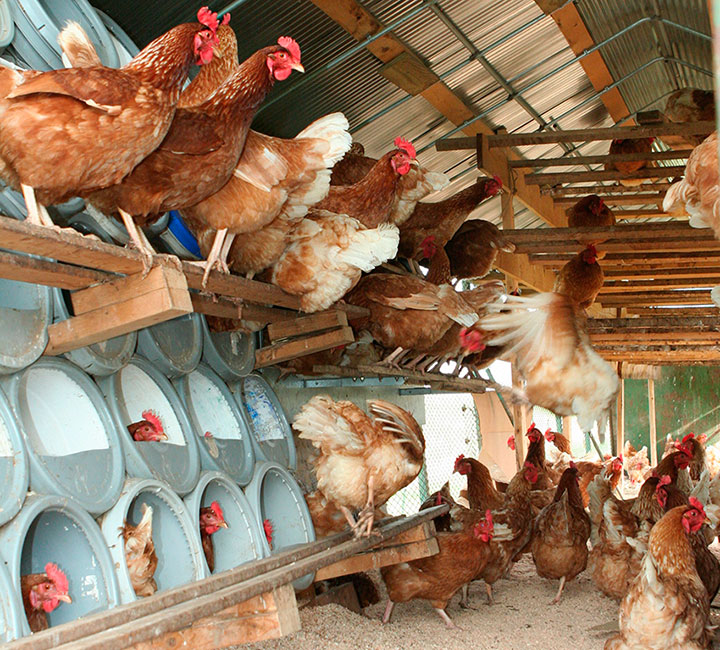
To solve the problem of ventilation, you need to determine its type. The next step is to draw up a detailed diagram, then purchase materials. All that remains is to follow the technology and carry out the necessary work.
Organization of natural air exchange
It is based on the parameters of the air: temperature, pressure, wind speed. This type of ventilation can be either unregulated or organized. Unorganized ventilation occurs through leaking doors and windows; air infiltration occurs through walls and ceilings.
For organized air circulation (aeration), you need to provide a small window, placing it in the ceiling above the perch or directly above the doorway. To control traction, the window is made in the form of a window.
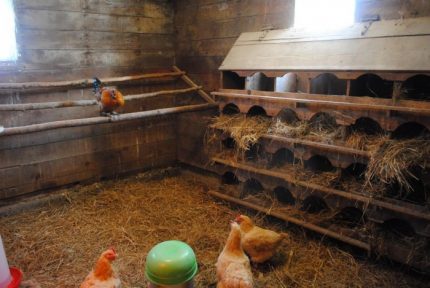
The door in the open state will supply the house with fresh air, and the exhaust will go through the window. This method is good for the warm season. In winter, the effect of such ventilation is negligible. It is unprofitable, because it takes a lot of heat. You will have to spend a lot of money on maintaining the optimal temperature inside the house.
The most primitive circulating or open system, suitable for a room of about 9 m², consists of 2 sewer or ventilation plastic pipes 2 meters long, 200 mm cross-section and a 90⁰ elbow. One of the pipes will act as a hood.It is mounted above the perch at the ceiling level or slightly lower.
It should rise 1-15 m above the roof. To do this, make a hole of the appropriate size, insert the pipe and elbow, blow the cracks into the mounting foam.
On the opposite side, the second pipe is installed in the same way, positioning it 0.5 m below the level of the first, 20-25 centimeters should remain to the floor. In order not to provoke drafts, the supply pipe is located away from the perch.
Installation, taking into account regulatory requirements, involves the exit of the opposite end of the pipe 0.3 m beyond the roof.
Be sure to install dampers on the pipes. To prevent dust and precipitation from entering the room through pipes, their ends are made L-shaped or umbrellas are installed. You can purchase and install special nozzles - baffles. Under the influence of wind, they increase the rarefaction of air in the pipe. The outside of the pipes is plastered and painted. This will insure against the formation of cracks in the future.
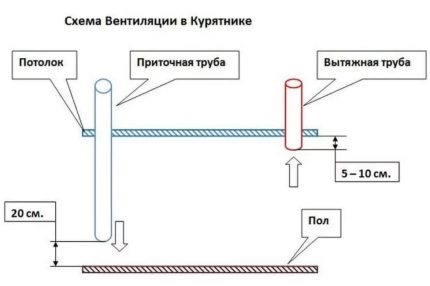
The most effective air circulation is provided by pipes with a circle in cross section. It is better to insulate plastic and metal products, otherwise in winter condensation will appear on the inner walls. When freezing, after a while it can block the ventilation passage completely.
To securely lock plastic ducts they are installed near the rafters, in some cases, additionally fixed with brackets. Sometimes instead of pipes, channels from the boards are arranged. In this case, special attention should be paid to their sealing.
At very low temperatures, the air damper shuts off and, if not installed, protects the openings from the wind flow with a rag. In summer, the air ducts open completely.
There is another simple ventilation method for a small chicken coop:
- A box is constructed from planks, having a cut square of 200 x 200 mm. Install the structure vertically.
- Divide the inside of the channel in half.
- Close the top of the box.
- Seal and paint the outer surface of the channel.
- Drill holes in the sidewalls.
The part of the channel, located on the leeward side, will provide air supply to the chicken coop. Exhaust air will escape through the second half of the duct.
If the chicken coop area is large, more solid ventilation is used in it, acting according to the supply and exhaust principle. For this, preliminary miscalculations are performed and an individual project is created. It is important to choose the right cross-section of the pipes so that the air flows do not create drafts.
For ventilation pipes, you can purchase ready-made check valves both round and rectangular in cross section. Their design includes a housing of the corresponding section and a damper. Round valves are made of galvanized sheet metal, and rectangular valves are made of aluminum sheet.
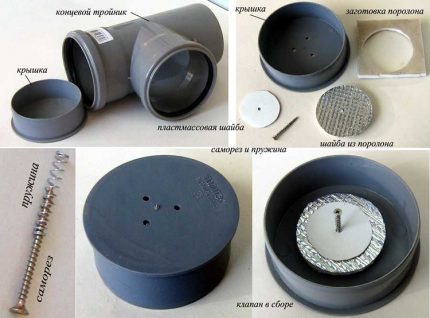
Valves with a shutter, the position of which is manually adjusted, are marked with the letter P. If the model is controlled by an electric or pneumatic actuator, then the letter E or P is present in the designation, respectively. You can use a standard round valve with a pipe diameter of 250 mm. The feasibility of their use is determined by the scale of the house.
Mechanical system
The task of mechanical drawing is to provide an optimal mode regardless of the weather. In a small-scale economy, its use does not always justify the costs associated with paying for electricity. It is impossible to recoup costs if hens are raised only for the needs of the family.
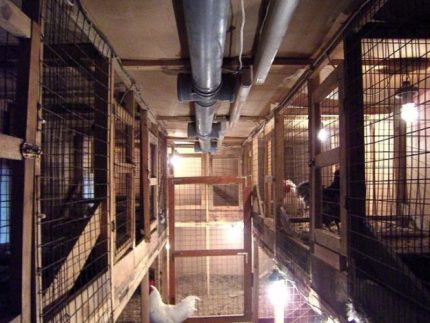
This type of ventilation is similar to the supply and exhaust method, but here a somewhat improved technology is used, which consists in the use of fans. In some cases, the system is controlled in manual mode, in others there are special control panels.
The mechanical ventilation scheme for use in winter contains two pipes and duct fan, location, which depends on the type of circulation. To ensure supply ventilation, it is placed in the supply pipe. With an efficient exhaust device, the fan must be in the exhaust pipe.
The installation process is almost the same as with the supply and exhaust ventilation device:
- Install 2 pipes.
- Drill holes for condensate at the end of the chimney.
- Lay the wiring to the fan installation site.
- Mount the switch. There can be 2 options: a switch that turns on both the light and the hood or a 2-key view of the switch that allows you to control the lighting and the hood separately.
- Install a fan.
In a simplified version of the mechanical retraction household axial fan placed in the wall on the ceiling or in the window pane. The last option is the easiest. They try on a fan, cut a rectangle of OSB or plywood to fit the glass.
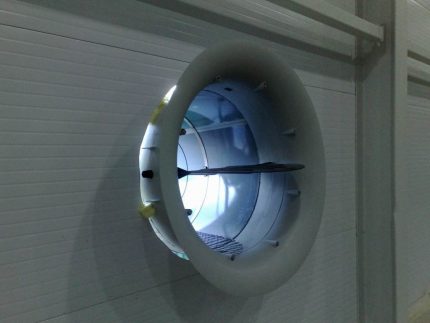
Mark up and cut out the opening for the fan, then insert the element into the frame and fix it with screws. The fan itself is inserted into the resulting hole. The method of securing the latter depends on its design.
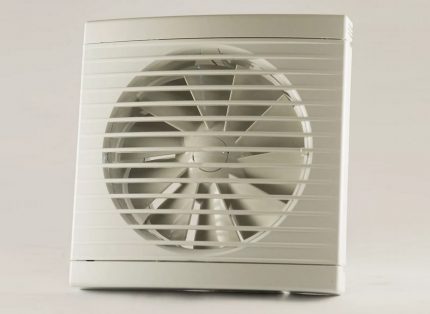
The fan included in the system is connected to the mains. Wiring is better to lay outside the chicken coop, because inside for this condition is not quite suitable. It is important to carefully insulate the wiring.
Such ventilation is not necessary to leave in working condition for a long time. It can work only 2-3 hours a day and this will be enough for effective ventilation.
For ease of control, sensors are installed. At a certain humidity and temperature, they turn ventilation on and off. Sometimes the pipes are placed in the attic, and the fan is in the ceiling.
Manufacturing a vent for a vent riser
Install it on a ventilation riser towering above the roof. The deflector works as follows: it cuts the wind directed in its direction, which leads to a decrease in pressure inside the device and increased traction in the exhaust duct.
Independent manufacture of a wind turbine will cost inexpensively, and the effect is impressive. Install it on the roof. Before proceeding to its manufacture, it is necessary to calculate the dimensions.
To calculate the height, the diameter of the ventilation pipe is multiplied by 1.7. Multiplying the diameter by 1.8, you get the width of the cap, and when you multiply this parameter by 1.3, you know the necessary width of the diffuser.
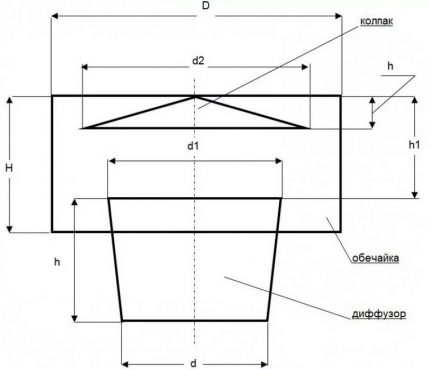
Having calculated the sizes, they are applied to cardboard and patterns are cut out. Further, the development of the cap, sketches of the blanks of the diffuser, cylinder and racks are transferred to a metal sheet or plastic. Using scissors, cut out all the parts and connect them using a special gun. It remains to install and fix the deflector.
You can make a rotary valve yourself. For this, a frame is welded from the corners.On opposite sides of the frame, holes are drilled and an axis is threaded through them. Sleeves are made from pipe segments, welded.
A steel plate is made of a stop plate according to the size of the pipe. It is inserted into the frame, fixed to the axis by welding. To control the shutter, a wooden handle is fixed on the axis. To ensure that the shutter does not close spontaneously, a limiter is provided.
The disadvantage of such a ventilation system is the fact of the presence of pipes in the room. From their surface, as well as from a perch, it will be necessary to periodically scrape off the litter.
Conclusions and useful video on the topic
Presentation of a home-made ventilation system in the house with a visual demonstration of the design:
Together with the author of the video, you can do the ventilation in the chicken house yourself:
Any business can be mastered if you carefully follow the instructions. Do the hood in your own chicken house with your own hands and your birds will feel much better.
Want to talk about how to build ventilation in your own chicken house? Do you know the nuances of its device that are not mentioned in the article? Please write comments in the block below, ask questions on controversial and obscure points.

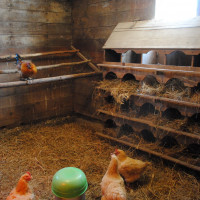 DIY ventilation in the chicken house in winter: the best schemes and subtleties of arrangement
DIY ventilation in the chicken house in winter: the best schemes and subtleties of arrangement 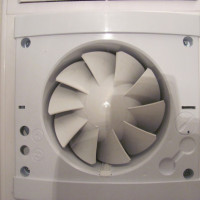 Hood for bathroom and toilet: the subtleties of creating a project and the nuances of arranging the system
Hood for bathroom and toilet: the subtleties of creating a project and the nuances of arranging the system 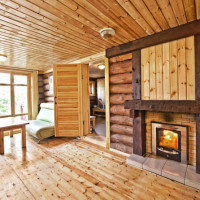 Ventilation in the dressing room: options and methods for arranging the air exchange system
Ventilation in the dressing room: options and methods for arranging the air exchange system 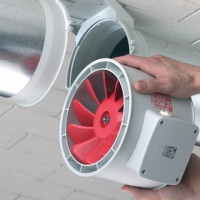 How to determine fan pressure: ways to measure and calculate the pressure in the ventilation system
How to determine fan pressure: ways to measure and calculate the pressure in the ventilation system 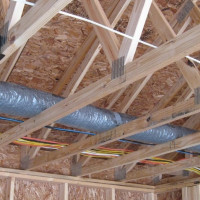 Ventilation in the house from sip panels: the best options and layouts
Ventilation in the house from sip panels: the best options and layouts  Is it possible to bring ventilation to the attic in a private house? The best accommodation options
Is it possible to bring ventilation to the attic in a private house? The best accommodation options  How much does it cost to connect gas to a private house: the price of organizing gas supply
How much does it cost to connect gas to a private house: the price of organizing gas supply  The best washing machines with dryer: model rating and customer tips
The best washing machines with dryer: model rating and customer tips  What is the color temperature of light and the nuances of choosing the temperature of the lamps to suit your needs
What is the color temperature of light and the nuances of choosing the temperature of the lamps to suit your needs  Replacement of a geyser in an apartment: replacement paperwork + basic norms and requirements
Replacement of a geyser in an apartment: replacement paperwork + basic norms and requirements
For air circulation, I usually at noon, when the temperature is as warm as possible, I open the window. Additionally, the husband did not make a hole. An hour is usually enough, after which I start cleaning up there. Breathes easily. The window, by the way, is made from the side of the bath, air enters, but does not blow out much at the same time. And rodents not only spoil the air with their presence, but also spoil the food and sometimes they eat eggs. For them I set traps with glue. It’s very convenient: a bird, even if it comes or tries, will not recover, and the mouse cannot get out of it on its own.
Once a day, opening the window is clearly not enough for normal ventilation. In winter, this method is generally not applicable, let the cold.
A hood in the chicken coop is definitely needed. From childhood I remember the aroma of the room where our family raised chickens. The smell is still the same))) But during my childhood there was no question of any special exhaust hoods in personal subsidiary farms, so they ventilated in the most accessible and banal way - they opened the doors and allowed the drafts to take out all the smells. For the bird, the draft is fatal, so it so happened that the hens were periodically sick. I am glad that even now you can not expose the bird to such endurance tests. He made a ventilation system for the house - and everyone is happy.
In my small chicken house with natural ventilation (50mm pipe), condensation constantly accumulates on the windows and in the corner, and the sawdust is also slightly damp. I will try forced with a fan.
First, try to calculate the amount of necessary air exchange for your chicken coop, and on the basis of this, choose the diameter of the pipes. They are placed on opposite walls, one at the bottom, the other at the top. If you do it right, you can easily do without forced ventilation.